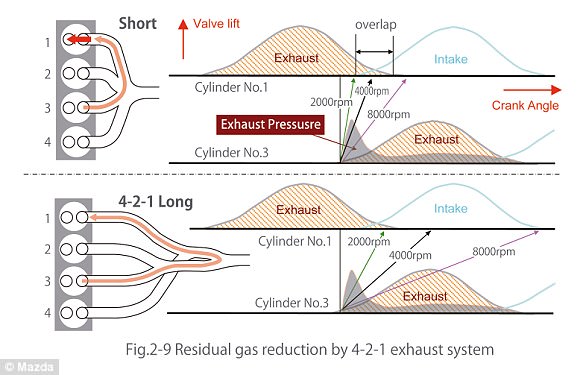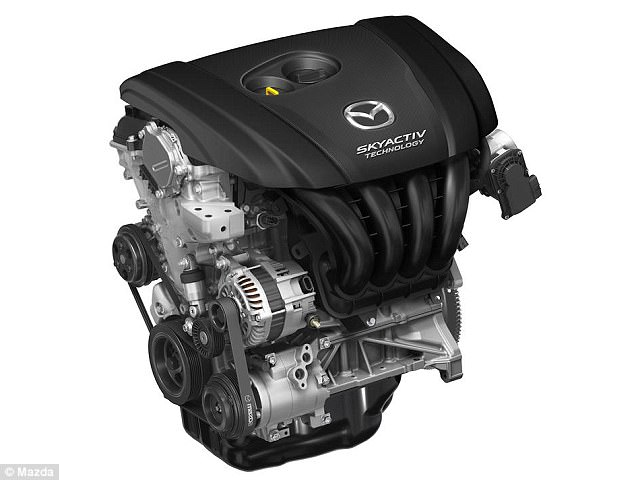CAPSLOCKSTUCK
Spaced Out Lunar Tick
- Joined
- Feb 26, 2013
- Messages
- 8,578 (1.92/day)
- Location
- llaregguB...WALES
| System Name | Party On |
|---|---|
| Processor | Xeon w 3520 |
| Motherboard | DFI Lanparty |
| Cooling | Big tower thing |
| Memory | 6 gb Ballistix Tracer |
| Video Card(s) | HD 7970 |
| Case | a plank of wood |
| Audio Device(s) | seperate amp and 6 big speakers |
| Power Supply | Corsair |
| Mouse | cheap |
| Keyboard | under going restoration |
Its fuel economy potentially matches that of a diesel engine without high emissions of nitrogen oxides or sooty particulates.
Mazda's engine employs spark plugs under certain conditions, such as at low temperatures, to overcome technical hurdles that have hampered commercialization of the technology.
HOW IT WORKS
A homogeneous charge compression ignition (HCCI) engine ignites petrol through compression, eliminating spark plugs.
Its fuel economy potentially matches that of a diesel engine without high emissions of nitrogen oxides or sooty particulates.
Mazda's engine employs spark plugs under certain conditions, such as at low temperatures, to overcome technical hurdles that have hampered commercialization of the technology.
To keep the temperature low at compression, the system reduces the amount of hot exhaust gas inside the combustion chamber.

+3
To keep the temperature low at compression, the system reduces the amount of hot exhaust gas inside the combustion chamber using a 4-2-1 exhaust system
In the Skyactiv-G, for example – the predecessor to the Skyactiv-X – Mazda uses a 4-2-1 exhaust system.
This relies on a pipe with a length over 600mm to elevate actual-use torque, and a loop shape to save space.
As the long distance cools the exhaust gas before it reaches the catalyst, which would then delay the catalyst’s activation, the system delays ignition timing after engine-start for stable combustion.
A piston cavity is used to optimize fuel injection further, to formulate a stratified air-fuel mixture around the spark plug, according to Mazda.

http://www.mazda.com/en/innovation/technology/skyactiv/skyactiv-g/
Mazda's engine employs spark plugs under certain conditions, such as at low temperatures, to overcome technical hurdles that have hampered commercialization of the technology.
HOW IT WORKS
A homogeneous charge compression ignition (HCCI) engine ignites petrol through compression, eliminating spark plugs.
Its fuel economy potentially matches that of a diesel engine without high emissions of nitrogen oxides or sooty particulates.
Mazda's engine employs spark plugs under certain conditions, such as at low temperatures, to overcome technical hurdles that have hampered commercialization of the technology.
To keep the temperature low at compression, the system reduces the amount of hot exhaust gas inside the combustion chamber.

+3
To keep the temperature low at compression, the system reduces the amount of hot exhaust gas inside the combustion chamber using a 4-2-1 exhaust system
In the Skyactiv-G, for example – the predecessor to the Skyactiv-X – Mazda uses a 4-2-1 exhaust system.
This relies on a pipe with a length over 600mm to elevate actual-use torque, and a loop shape to save space.
As the long distance cools the exhaust gas before it reaches the catalyst, which would then delay the catalyst’s activation, the system delays ignition timing after engine-start for stable combustion.
A piston cavity is used to optimize fuel injection further, to formulate a stratified air-fuel mixture around the spark plug, according to Mazda.

http://www.mazda.com/en/innovation/technology/skyactiv/skyactiv-g/






 ) dirty? well, which combustion motor isn't dirty... (even the new Mazda Skyactive is still a dirty engine, even if it is more efficient ) efficient? hum, technically no engine is really efficient , but true the Wankel design was too much fuel hungry ...
) dirty? well, which combustion motor isn't dirty... (even the new Mazda Skyactive is still a dirty engine, even if it is more efficient ) efficient? hum, technically no engine is really efficient , but true the Wankel design was too much fuel hungry ...

